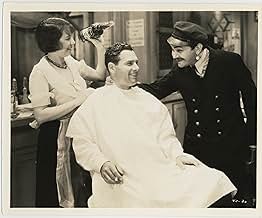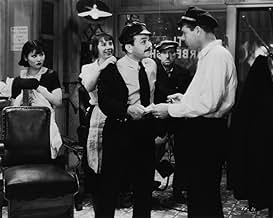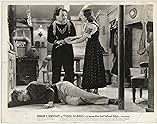ÉVALUATION IMDb
6,3/10
1,2 k
MA NOTE
Ajouter une intrigue dans votre langueA tuna fisherman marries a woman who doesn't love him.A tuna fisherman marries a woman who doesn't love him.A tuna fisherman marries a woman who doesn't love him.
- Prix
- 2 victoires au total
J. Carrol Naish
- Tony
- (as J. Carroll Naish)
Sheila Bromley
- 'Red'
- (uncredited)
Wong Chung
- Chinese Laundryman
- (uncredited)
Edwin Maxwell
- Doctor
- (uncredited)
Toshia Mori
- Oriental Lady Barber
- (uncredited)
Henry Otho
- Crewman
- (uncredited)
Inez Palange
- Mike's Neighbor
- (uncredited)
Pedro Regas
- Crewman
- (uncredited)
Joe Roig
- Undetermined Secondary Role
- (uncredited)
Hector V. Sarno
- Crewman
- (uncredited)
Harry Semels
- Crewman
- (uncredited)
Avis en vedette
Portuguese fisherman (Edward G. Robinson) loses a hand to a shark and later loses his young wife (Zita Johann) to his best friend (Richard Arlen). He doesn't like it. A simple plot that was reused by Warner Bros. many times over the years. It's an okay early film from Howard Hawks. Worth watching for Robinson's colorful performance. Eddie G's sporting an earring and a hook for a hand, folks. It's not Shakespeare but it's hard to look away. Real maritime footage is a plus. Classic horror fans will recognize Zita Johann from The Mummy, which was released this same year. She's a lot more subtle in this than in that film.
I had once taped this one off Italian TV (during a lengthy Howard Hawks season of films shown in English but with Italian subtitles) but my VCR developed a fault and the recording was subsequently unwatchable! I sure am glad to have caught up with it now
First of all, Edward G. Robinson is the whole show here: his portrayal of the central character, a Portuguese fisherman who sees himself as the best in the business and speaks in amiable broken English (his catchphrase is: "Absolutely indeed") is first-rate and it was also quite funny to watch him sporting an earring. The plot is predictable enough (a woman comes between two best friends and the situation is resolved through tragedy) but that may be because the same elements were recycled so many times, even by Warner Bros. themselves, over the years: SLIM (1937), THE WAGONS ROLL AT NIGHT (1941), Raoul Walsh's MANPOWER (1941; with Marlene Dietrich coming between Edward G. Robinson and George Raft), etc.
Even more importantly, however, the imprint of director Howard Hawks is all over it: the vivid recreation of a man's world, the bonds which grow stronger through the everyday adversity which that entails, the invasion of a woman into this enclosed world which sets about the inevitable tragedy, etc. In fact, the brotherly (or even father-son) relationship seen here between Robinson and his younger protégée, Richard Arlen, is reprised in many another Hawks film Pat O'Brien and James Cagney in CEILING ZERO (1935), Thomas Mitchell and Cary Grant in ONLY ANGELS HAVE WINGS (1939), Walter Brennan and Humphrey Bogart in TO HAVE AND HAVE NOT (1944), John Wayne and Dean Martin in RIO BRAVO (1959), etc; the unceremonious intrusion of the female character onto a perfectly ordered way of life is also seen enacted by Katharine Hepburn in BRINGING UP BABY (1938), Jean Arthur in ONLY ANGELS HAVE WINGS, Barbara Stanwyck in BALL OF FIRE (1941), Lauren Bacall in TO HAVE AND HAVE NOT, Joanne Dru in RED RIVER (1948), Margaret Sheridan in THE THING FROM ANOTHER WORLD (1951), Angie Dickinson in RIO BRAVO, Elsa Martinelli in HATARI! (1962) and Paula Prentiss in MAN'S FAVORITE SPORT? (1964); early on, the "boys" in TIGER SHARK are gathered around drinking and singing to their hearts' content a similar instance occurs also in ONLY ANGELS HAVE WINGS, RIO BRAVO and HATARI! Besides Robinson's performance and the fascinating early look at the Hawksian themes elaborated on more fully in his later films, TIGER SHARK is also notable for its exciting fishing sequences especially the rather grisly (for their time) shark attacks; the scene where Robinson loses his hand to one of the marauding beasts is particularly effective.
Actually, this viewing of TIGER SHARK has reminded me of several notable films which Robinson appeared in around the same time but with which I'm not all that familiar having watched them only once years ago, namely TWO SECONDS (1932), THE MAN WITH TWO FACES (1934), John Ford's THE WHOLE TOWN'S TALIKING (1935), Hawks' own BARBARY COAST (1935), THE LAST GANGSTER (1937), A SLIGHT CASE OF MURDER (1938), THE AMAZING DR. CLITTERHOUSE (1938), CONFESSIONS OF A NAZI SPY (1939), THE SEA WOLF (1941) and MANPOWER!
Even more importantly, however, the imprint of director Howard Hawks is all over it: the vivid recreation of a man's world, the bonds which grow stronger through the everyday adversity which that entails, the invasion of a woman into this enclosed world which sets about the inevitable tragedy, etc. In fact, the brotherly (or even father-son) relationship seen here between Robinson and his younger protégée, Richard Arlen, is reprised in many another Hawks film Pat O'Brien and James Cagney in CEILING ZERO (1935), Thomas Mitchell and Cary Grant in ONLY ANGELS HAVE WINGS (1939), Walter Brennan and Humphrey Bogart in TO HAVE AND HAVE NOT (1944), John Wayne and Dean Martin in RIO BRAVO (1959), etc; the unceremonious intrusion of the female character onto a perfectly ordered way of life is also seen enacted by Katharine Hepburn in BRINGING UP BABY (1938), Jean Arthur in ONLY ANGELS HAVE WINGS, Barbara Stanwyck in BALL OF FIRE (1941), Lauren Bacall in TO HAVE AND HAVE NOT, Joanne Dru in RED RIVER (1948), Margaret Sheridan in THE THING FROM ANOTHER WORLD (1951), Angie Dickinson in RIO BRAVO, Elsa Martinelli in HATARI! (1962) and Paula Prentiss in MAN'S FAVORITE SPORT? (1964); early on, the "boys" in TIGER SHARK are gathered around drinking and singing to their hearts' content a similar instance occurs also in ONLY ANGELS HAVE WINGS, RIO BRAVO and HATARI! Besides Robinson's performance and the fascinating early look at the Hawksian themes elaborated on more fully in his later films, TIGER SHARK is also notable for its exciting fishing sequences especially the rather grisly (for their time) shark attacks; the scene where Robinson loses his hand to one of the marauding beasts is particularly effective.
Actually, this viewing of TIGER SHARK has reminded me of several notable films which Robinson appeared in around the same time but with which I'm not all that familiar having watched them only once years ago, namely TWO SECONDS (1932), THE MAN WITH TWO FACES (1934), John Ford's THE WHOLE TOWN'S TALIKING (1935), Hawks' own BARBARY COAST (1935), THE LAST GANGSTER (1937), A SLIGHT CASE OF MURDER (1938), THE AMAZING DR. CLITTERHOUSE (1938), CONFESSIONS OF A NAZI SPY (1939), THE SEA WOLF (1941) and MANPOWER!
Tiger Shark (1932)
*** (out of 4)
A lonely fisherman (Edward G. Robinson) marries a girl out of pity only to see her fall in love with his best friend. Director Howard Hawks does a very good job at showing off a wide range of emotions from sentiment to laughs to some very intense shark attack scenes. Robinson clearly steals the show with his touching performance but the supporting roles are good too. Another highlight is seeing the old time assembly line of having the fish removed from the boat and cleaned all in the matter of minutes. Apparently Warner loved this story so much that they remade it three times within the next ten years including Robinson returning in Manpower.!!!
*** (out of 4)
A lonely fisherman (Edward G. Robinson) marries a girl out of pity only to see her fall in love with his best friend. Director Howard Hawks does a very good job at showing off a wide range of emotions from sentiment to laughs to some very intense shark attack scenes. Robinson clearly steals the show with his touching performance but the supporting roles are good too. Another highlight is seeing the old time assembly line of having the fish removed from the boat and cleaned all in the matter of minutes. Apparently Warner loved this story so much that they remade it three times within the next ten years including Robinson returning in Manpower.!!!
Sorry, I forgot to add a point to my comment that was rather an important one, at least to me. Tiger Shark was shot in the early 1930s and there are some interesting scenes of men sailing their boat into a school of tuna, guided by a lookout, then lining up in the leads and pulling the fish in using flexible poles, one at a time. The scenes are authentic and exciting. Alas, they are history. Tuna fisherman now use "long lines." (Koreans and Japanese have huge industries built around this technique.) The fishing boat now needs a smaller crew (less expensive) because there no longer any mano a mano contests between fish and man. The crew simply strings out long fishing lines, guided by sonar, more than a mile long, with baited hooks fixed to the lines at short, regular intervals, set for a given depth. This has proved far more lucrative than fishing exclusively for tuna with poles. The long lines have a tendency to clean everything that swims out of the sea; not just tuna but sharks, sea turtles, porpoises, and game fish like marlin (which can't be legally sold). By the time they are harvested, many of the animals are already dead, especially the air-breathing turtles and porpoises. The industry has become much more efficient and without passion. Mike probably wouldn't have approved but the organization that would now own his boat would have.
The plot of this film is nothing to write home about. Other reviewers have aptly summed it up as the quintessential love triangle. There are two things that make this film rise above 4 or 5 stars out of ten.
The first is the great footage of commercial fishing as it was practiced circa 1930. It really was man versus the sea back in those days. There is also some footage of how the fish is delivered and then processed once the fishing boat docks.
The second thing that makes this an interesting film is the odd combination of Edward G. Robinson on the way up, Richard Arlen on the way down, and Zita Johann in one of her few film appearances before she shrugged her shoulders and walked away from film after she decided she didn't need all the irritation she had to deal with as a Hollywood star.
Edward G. Robinson was a newcomer to talking films, having only one credited film appearance in silents, that being in 1916. Not a classicly good-looking man, he was fascinating to watch in almost any role because of his talent for drama as well as comedy. Richard Arlen was a great leading man over at Paramount, and even retained his position at that studio for a few years after sound came in. He had the looks, he had the voice, but his popularity fizzled nonetheless. Zita Johann does not have, as others have mentioned, a thick accent. Her diction is perfect, and she has exotic looks that can only be compared to Kay Francis.
Thus these three are thrown together in this film in exactly the way you'd believe them to be. Robinson as the likable fisherman, Mike, with a big heart who can't get a girl to love him because he is missing a hand that was taken by a shark. Zita Johann is the daughter of a fisherman on Mike's boat who falls overboard and is killed by a shark. Mike nurses her back to health - she is ill at the time her father dies - and takes care of her in general so that she feels beholden to marry him, plus she thinks she is through with love and feels that Mike will do as well as any man. Finally there is Arlen as Pipes, handsome friend of Mike. He and Mike's new wife fall in love but do not want to hurt someone that they feel has been very good to them.
There are two big problems with this plot. In execution, the problem is that we don't see any relationship build between Mike's wife and Pipes. She just announces to Pipes one night that she loves him and that is that. I realize there is not much room for character development in a 75 minute film, but they could have let this build a little bit. In concept, the whole fact that someone as likable as Mike would not be able to attract a woman just because he is missing a hand is a bit much. Women have not now nor have they ever been attracted to men just because of looks. Character counts a good deal more. This is a case of a man writing about women as though they were men.
In summary, if you run across this one it is always worthwhile to see Edward G. Robinson in action, but don't lose any sleep if it never comes your way.
The first is the great footage of commercial fishing as it was practiced circa 1930. It really was man versus the sea back in those days. There is also some footage of how the fish is delivered and then processed once the fishing boat docks.
The second thing that makes this an interesting film is the odd combination of Edward G. Robinson on the way up, Richard Arlen on the way down, and Zita Johann in one of her few film appearances before she shrugged her shoulders and walked away from film after she decided she didn't need all the irritation she had to deal with as a Hollywood star.
Edward G. Robinson was a newcomer to talking films, having only one credited film appearance in silents, that being in 1916. Not a classicly good-looking man, he was fascinating to watch in almost any role because of his talent for drama as well as comedy. Richard Arlen was a great leading man over at Paramount, and even retained his position at that studio for a few years after sound came in. He had the looks, he had the voice, but his popularity fizzled nonetheless. Zita Johann does not have, as others have mentioned, a thick accent. Her diction is perfect, and she has exotic looks that can only be compared to Kay Francis.
Thus these three are thrown together in this film in exactly the way you'd believe them to be. Robinson as the likable fisherman, Mike, with a big heart who can't get a girl to love him because he is missing a hand that was taken by a shark. Zita Johann is the daughter of a fisherman on Mike's boat who falls overboard and is killed by a shark. Mike nurses her back to health - she is ill at the time her father dies - and takes care of her in general so that she feels beholden to marry him, plus she thinks she is through with love and feels that Mike will do as well as any man. Finally there is Arlen as Pipes, handsome friend of Mike. He and Mike's new wife fall in love but do not want to hurt someone that they feel has been very good to them.
There are two big problems with this plot. In execution, the problem is that we don't see any relationship build between Mike's wife and Pipes. She just announces to Pipes one night that she loves him and that is that. I realize there is not much room for character development in a 75 minute film, but they could have let this build a little bit. In concept, the whole fact that someone as likable as Mike would not be able to attract a woman just because he is missing a hand is a bit much. Women have not now nor have they ever been attracted to men just because of looks. Character counts a good deal more. This is a case of a man writing about women as though they were men.
In summary, if you run across this one it is always worthwhile to see Edward G. Robinson in action, but don't lose any sleep if it never comes your way.
Le saviez-vous
- AnecdotesQuita wears traditional Portuguese attire for her wedding.
- GaffesWhen Quita tells Mike to leave her alone after being informed of her father's death, he responds twice with "yeah, all right". But Robinson as Mike drops the Portuguese accent he uses for the role and uses a regular American accent.
- Générique farfeluOpening Card: San Diego
- ConnexionsFeatured in Sharksploitation (2023)
- Bandes originalesAbdulla Bulbul Amir
(1877) (uncredited)
Written by William Percy French
Sung by Richard Arlen and members of the crew
Meilleurs choix
Connectez-vous pour évaluer et surveiller les recommandations personnalisées
Détails
- Durée
- 1h 17m(77 min)
- Couleur
- Mixage
- Rapport de forme
- 1.37 : 1
Contribuer à cette page
Suggérer une modification ou ajouter du contenu manquant




































